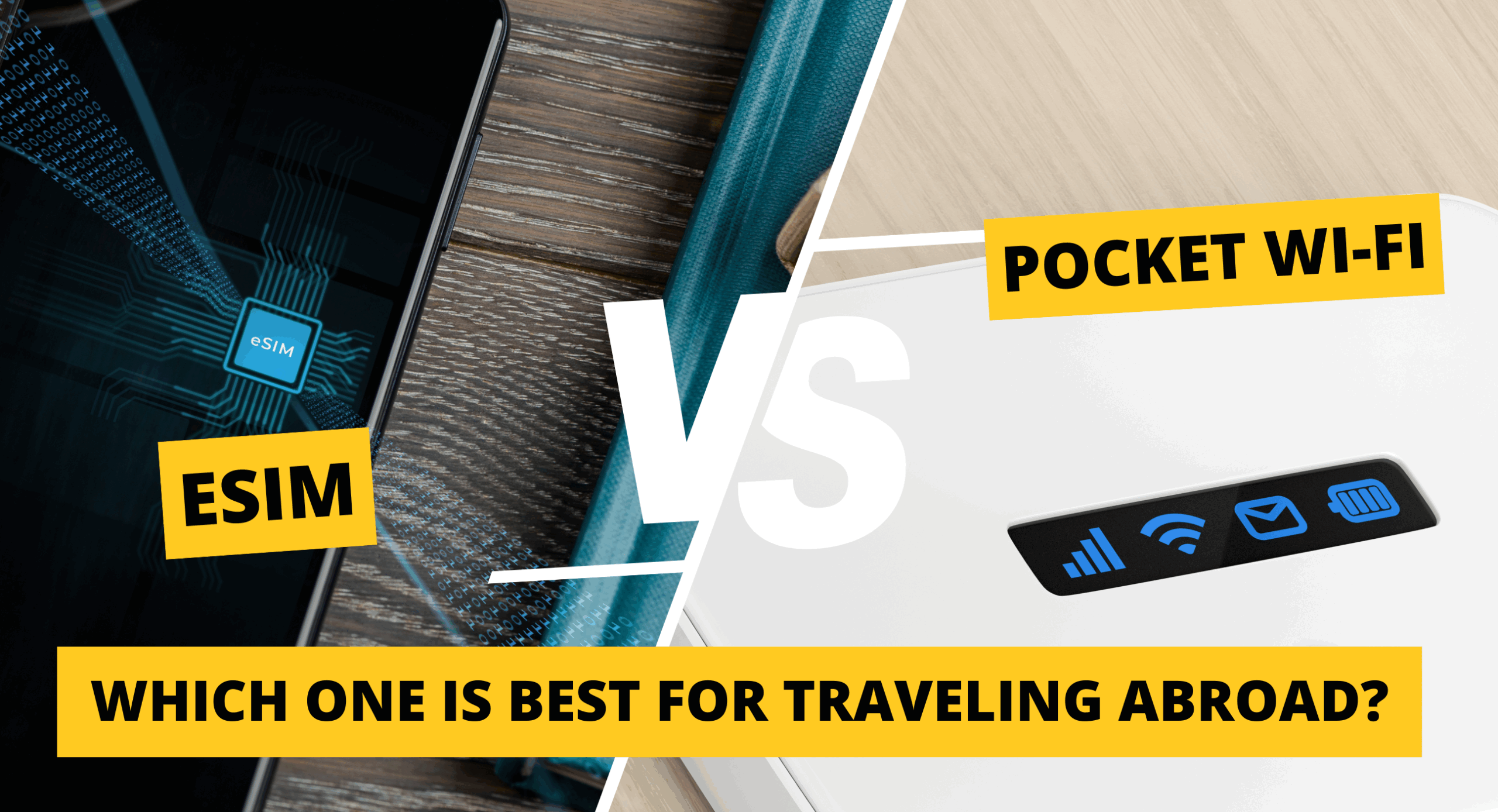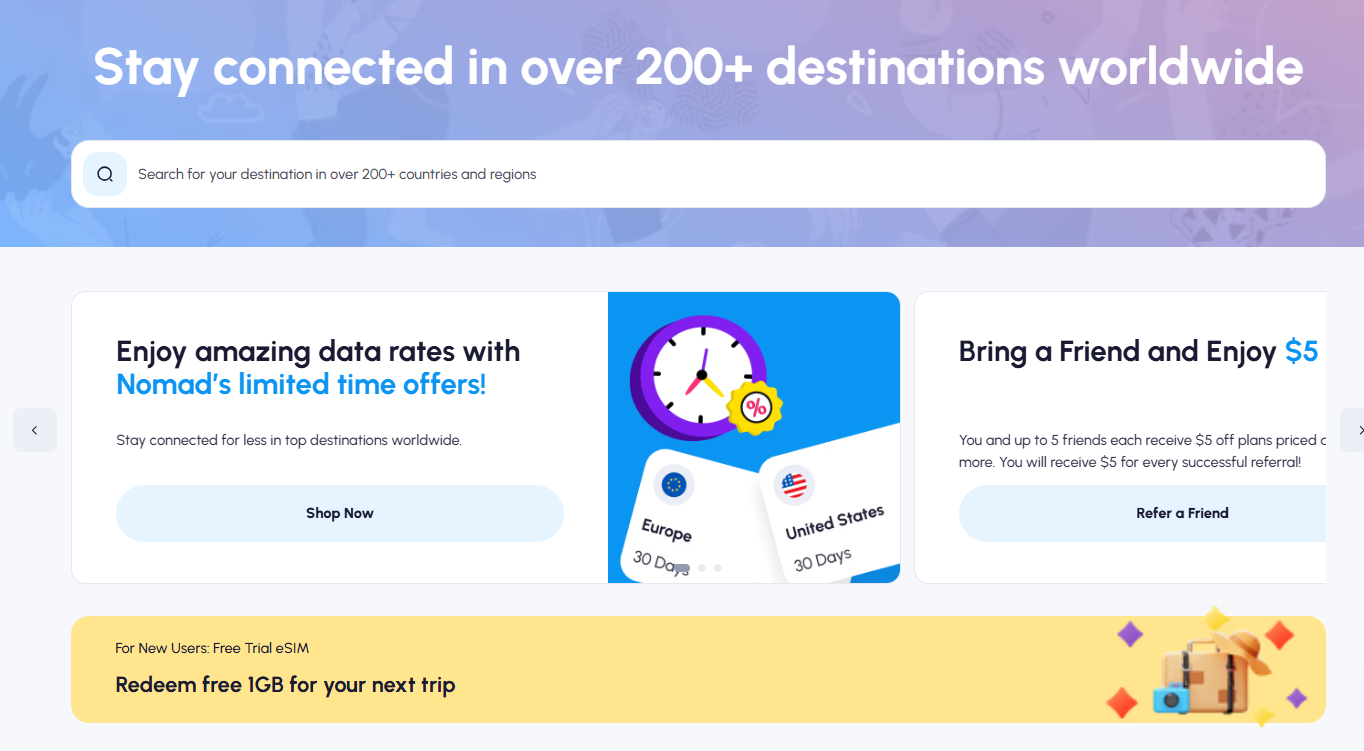Staying connected to the internet is essential when traveling abroad. There are many options, including pocket Wi-Fi, SIM cards, eSIMs, free Wi-Fi, and data roaming.
So, how should you stay online during your trip?
Which is better: eSIM or pocket Wi-Fi?
Is it better to prepare an eSIM or pocket Wi-Fi before leaving Japan?
This article answers these questions and helps you choose the best internet solution for your overseas travel.
What You’ll Learn in This Article
- Which is better for international travel: pocket Wi-Fi or eSIM?
- Pros and cons of pocket Wi-Fi
- Pros and cons of eSIM
- Which option suits you best? Travel-style based diagnosis
- How to choose between pocket Wi-Fi and eSIM
Which Is Best for You: eSIM or Pocket Wi-Fi? A Travel-Style Diagnosis
When traveling abroad, many people struggle to choose between eSIM and pocket Wi-Fi.
The most comfortable option can vary greatly depending on your travel style.
Check the guide below to see which option—eSIM or pocket Wi-Fi—is the best fit for you!
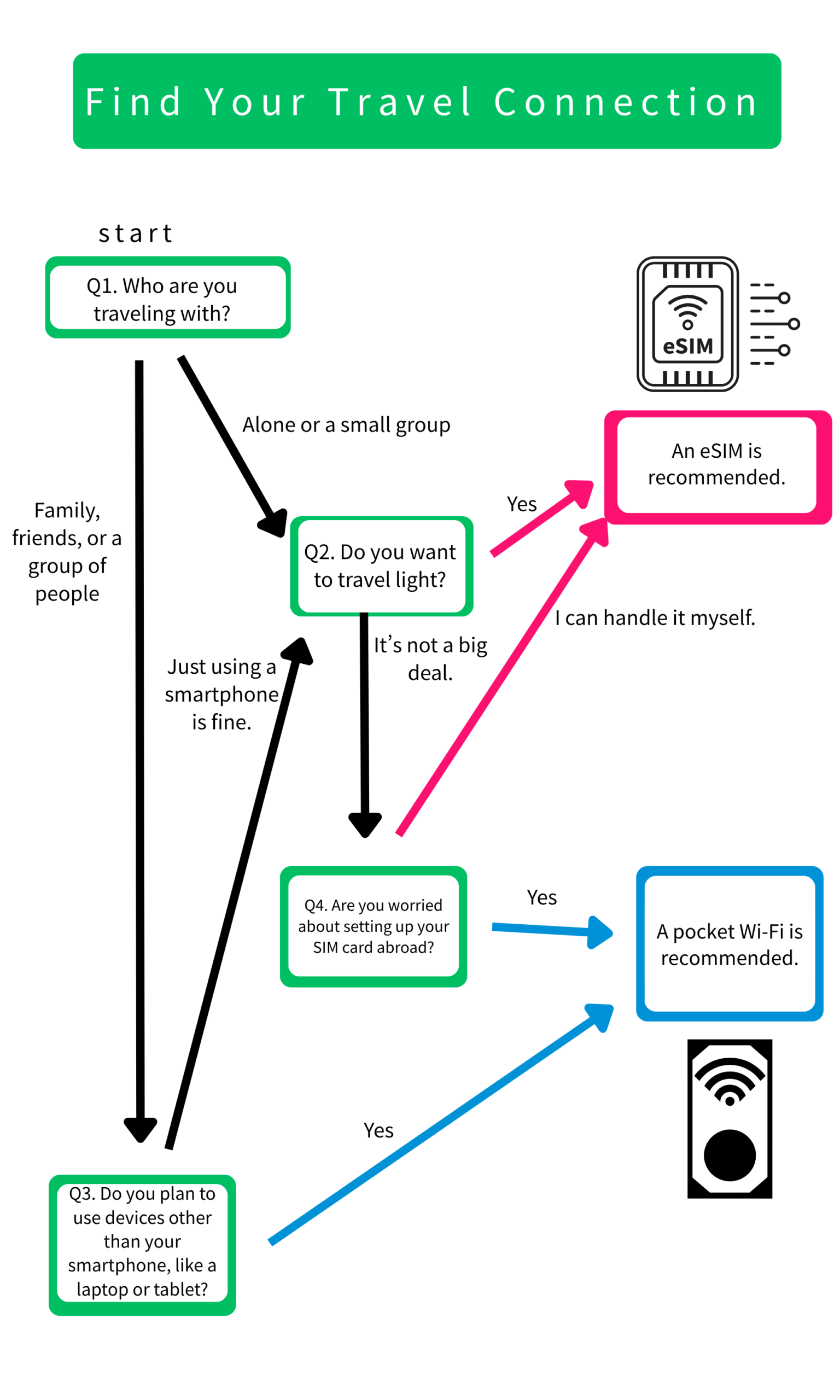
✅ Diagnosis Results Explained
Recommended for eSIM Users!
Perfect for travelers who want everything done on a single smartphone or prefer to keep luggage to a minimum.
Set it up before departure and enjoy instant internet access as soon as you arrive.
Recommended for Pocket Wi-Fi Users!
Ideal for those traveling with friends or family, or anyone planning to connect multiple devices like laptops or tablets.
It’s easy for anyone to use and offers stable connectivity.
Just remember to watch out for battery life and the extra bulk of carrying it around.
Koki Abe
eSIM Portal Administrator
Contents
- 1 eSIM Basics
- 2 Pocket Wi-Fi Basics
- 3 Pros and Cons of eSIM
- 4 Pocket Wi-Fi Advantages & Disadvantages for International Travel
- 5 Choosing the Right eSIM as an Alternative
- 6 How to Choose the Right Pocket Wi-Fi for Travel
- 7 Top 3 eSIM Services for International Travel in 2025
- 8 Top 2 Pocket Wi-Fi Services for International Travel
- 9 Summary | Which Should You Choose: eSIM or Pocket Wi-Fi?
- 10 Frequently Asked Questions
- 10.1 Do I need Wi-Fi if I have an eSIM?
- 10.2 Which is better for travel — SIM or Wi-Fi?
- 10.3 Does eSIM setup require Wi-Fi?
- 10.4 How much data do I need per day with an eSIM?
- 10.5 How long does a pocket Wi-Fi battery last?
- 10.6 Can I use eSIMs in every country?
- 10.7 Which is better for group travel?
- 10.8 Which suits long-term stays better?
- 10.9 Which is safer — eSIM or pocket Wi-Fi?
- 10.10 Which offers better battery life?
- 10.11 Which has faster connection speed?
eSIM Basics
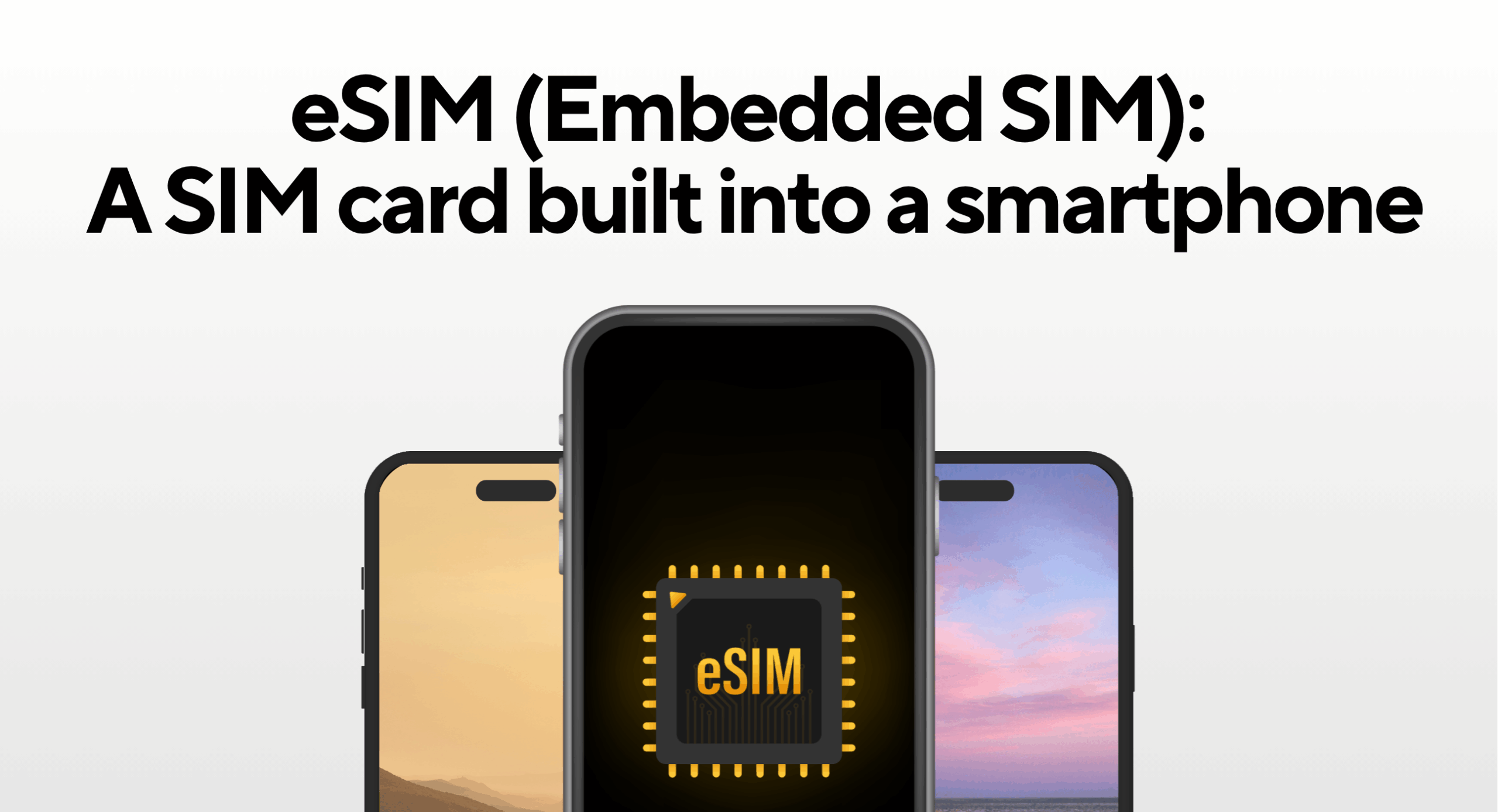
An eSIM (short for Embedded SIM) is a digital SIM that’s already built into your smartphone.
Unlike a physical SIM card, there’s no need to swap anything out—simply scan a QR code or download a profile through an app or your phone’s settings, and you’re ready to get online.
Activating an eSIM is quick and seamless; in many cases, you can start using mobile data in as little as 3 minutes. Thanks to its convenience, eSIM technology has become a popular way for travelers and business professionals to stay connected while abroad.
Pocket Wi-Fi Basics
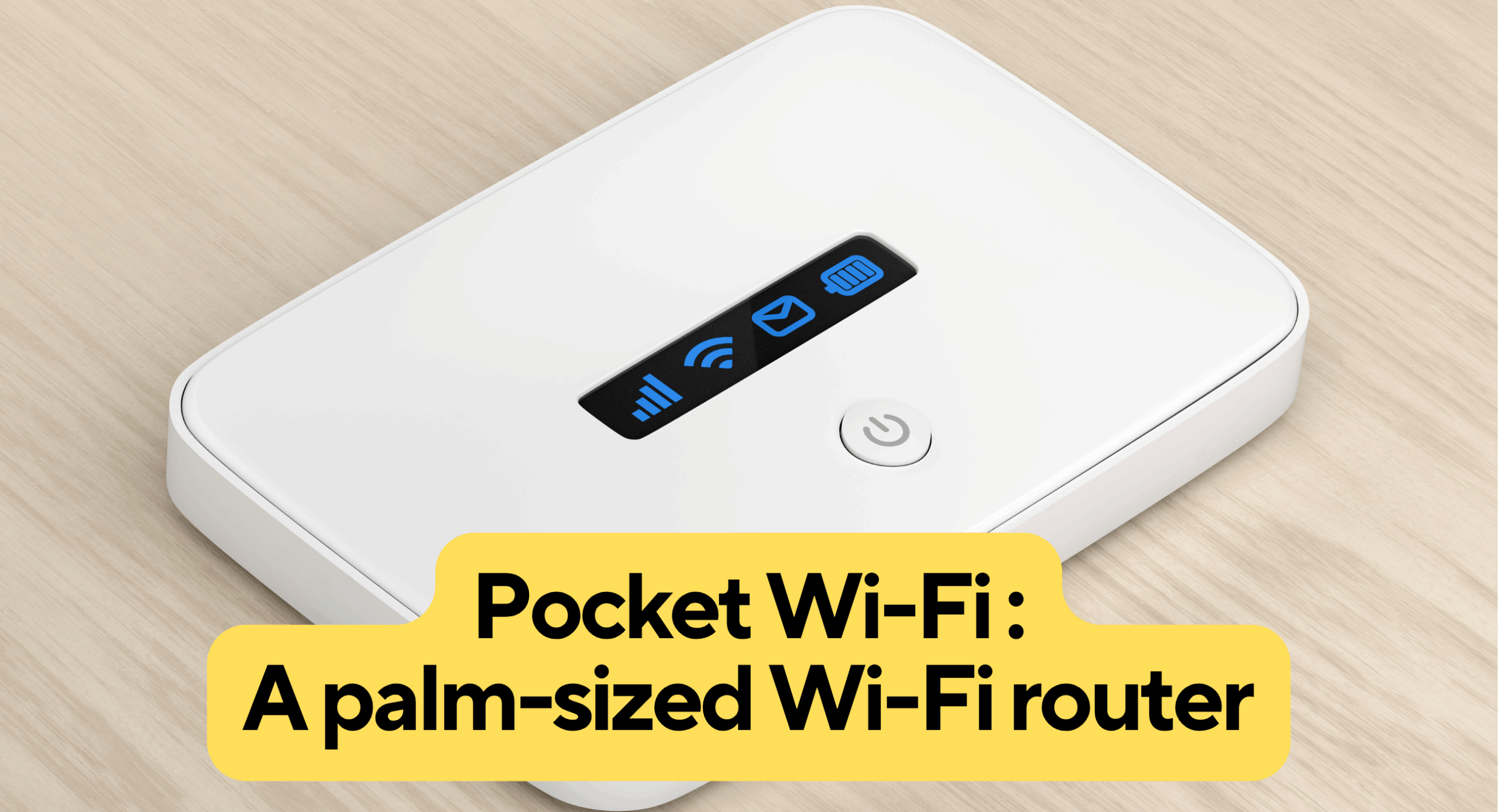
Pocket Wi-Fi is a small, battery-powered device that lets you connect your smartphone, laptop, tablet, and other gadgets to the internet while on the go.
Like a home Wi-Fi router, it can share a single connection with multiple devices nearby. Because it’s lightweight and rechargeable, pocket Wi-Fi is a handy option for overseas trips, work travel, or anytime you need reliable internet access away from home.
You can rent a unit online or at the airport, and many providers will deliver it to your door before departure. Once you arrive at your destination, just power it on, connect via Wi-Fi, and you’re ready to surf the web.
Pros and Cons of eSIM
As one of the easiest ways to secure internet access, eSIM usage has been growing rapidly in recent years.
Based on hands-on experience, here are three key advantages of using eSIMs for international travel.
3 Benefits of Using eSIM Abroad
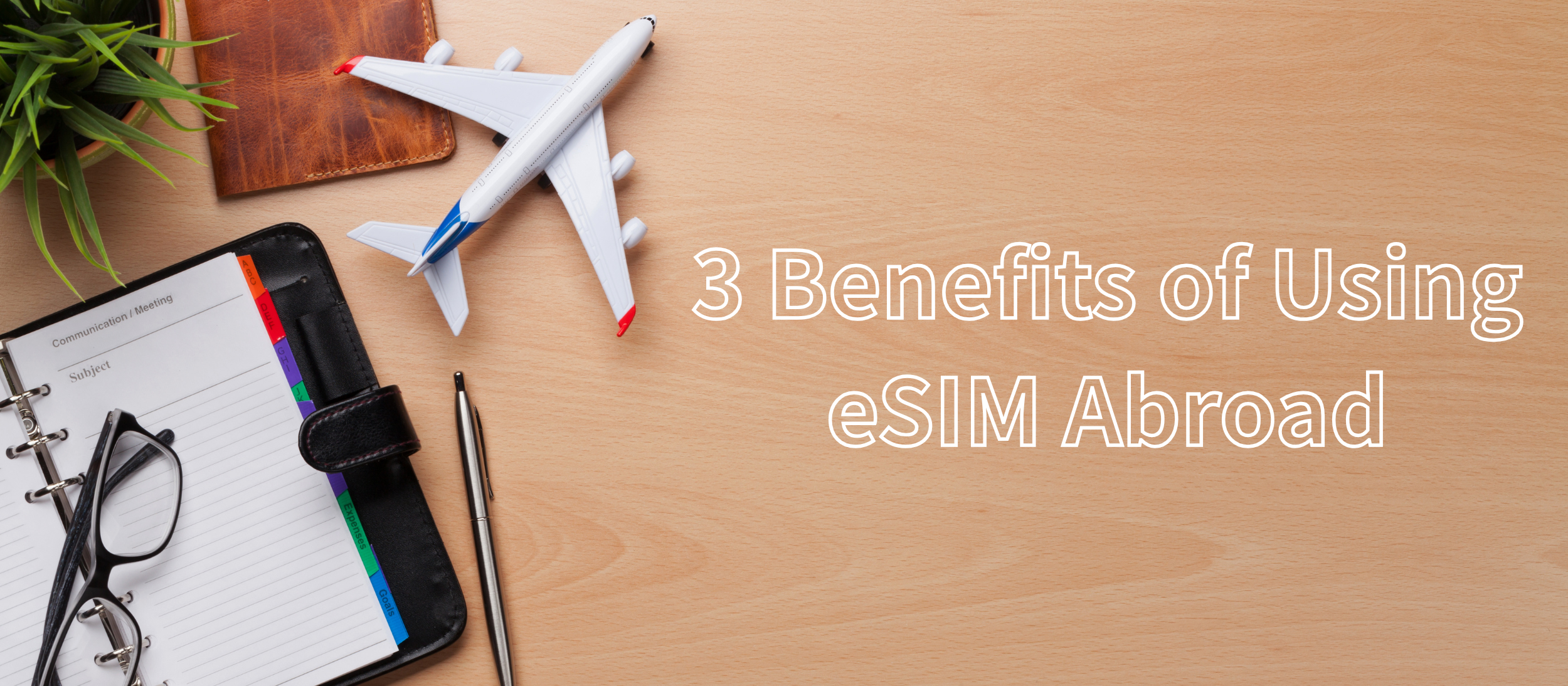
Top 3 Benefits of Using eSIMs for International Travel
- Get connected the moment you land
- No risk of loss or device damage
- Keep your Japanese phone number active
Let’s look at each benefit in detail.
Instant Connection Upon Arrival
When you arrive in a new country, having immediate internet access can make or break your trip. Whether you need to check your hotel location on a map, research public transport, or message friends and family, staying online right away is essential.
With an eSIM, you can set everything up before you leave Japan. As soon as you land, simply enable the line in your phone’s settings and turn on data roaming—no extra steps required.
Unlike pocket Wi-Fi, there’s no need to hunt for a pickup counter at the airport or wait in line for paperwork. There’s also no device to return or charge. For travelers who want a smooth online experience from the start, eSIMs offer unmatched convenience.
No Worries About Loss or Damage
Because an eSIM is installed directly on your smartphone, you don’t have to carry extra hardware. Unlike portable routers, there’s no risk of accidentally leaving it behind or paying high replacement fees if you lose it.
During international travel, you’re often on the move and juggling luggage. Having everything on one device reduces stress and potential costs. Plus, an eSIM doesn’t require charging, so there’s no need to monitor battery levels.
Keep Your Japanese Number Active
Another major advantage is the ability to keep your Japanese phone number while using a data plan abroad. You can easily switch between lines in your mobile settings, allowing you to use your eSIM for data while still receiving calls and SMS on your regular SIM.
This means you can get SMS, one-time passwords, and other important notifications without reconnecting to local Wi-Fi. For anyone who needs to stay reachable or receive verification codes, an eSIM is a safe, reliable solution. After returning home, simply toggle back to your domestic line to resume your usual service.
3 Drawbacks of Using eSIM Abroad
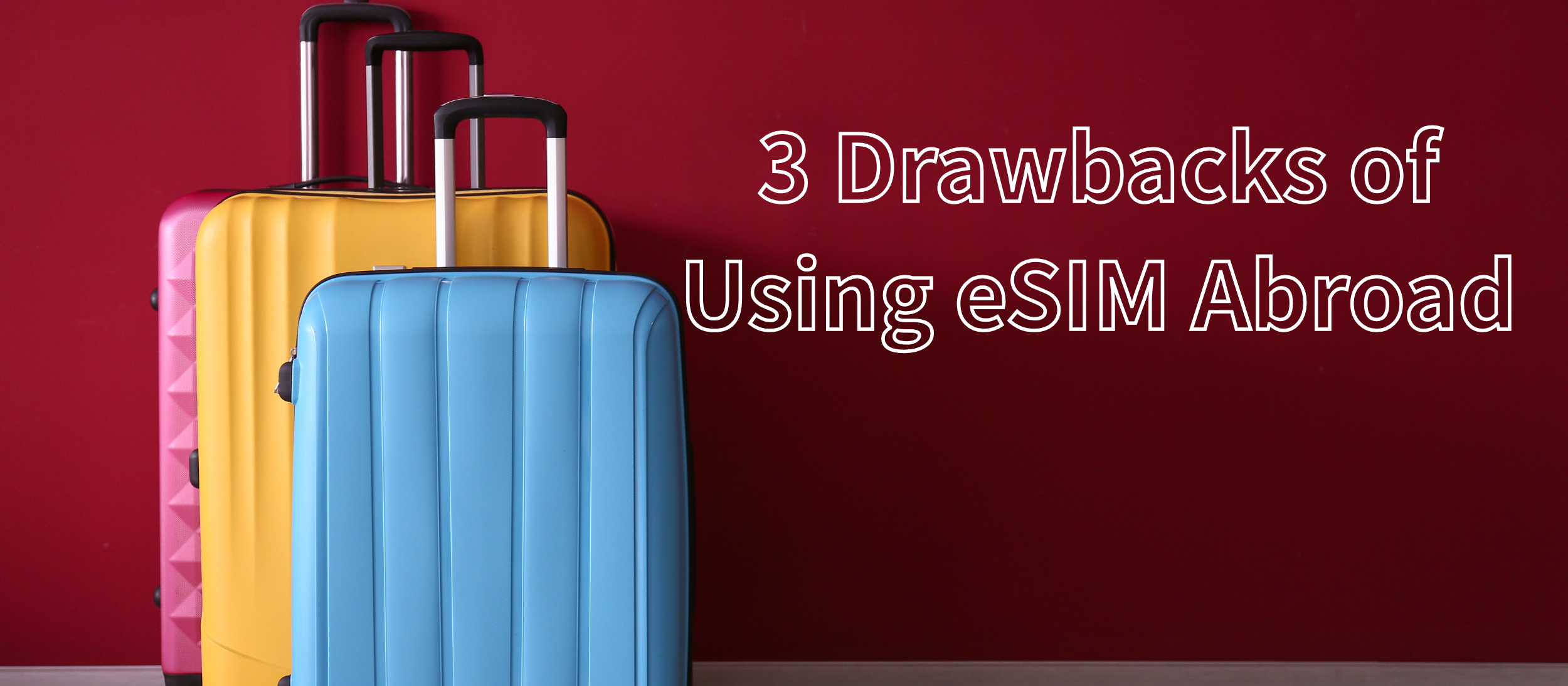
While eSIMs are extremely convenient, there are a few downsides to keep in mind when using them abroad.
Here are the top three disadvantages of using an eSIM while traveling overseas.
Top 3 Disadvantages of Using eSIMs Abroad
- Not all smartphones support eSIM
- Setup can be tricky for first-time users
- Some plans only provide data (no calls or SMS)
Limited Smartphone Compatibility
Although eSIMs are a great technology, not every smartphone supports them. Most newer models work without issue, but older devices or certain budget-friendly phones may not be compatible.
To avoid the frustration of purchasing an eSIM that doesn’t work on your device, check compatibility in advance. Many phones allow you to verify this in the settings, but procedures vary by brand and model. If you’re unsure, consult your carrier’s website or an updated eSIM compatibility list before departure. Confirming in advance ensures a smoother travel experience.
Setup Can Be Tricky
One of the biggest selling points of eSIMs is how easy they are to activate—just scan a QR code. However, if you’re not familiar with your phone’s settings, the process may feel more complicated than expected.
Trying to configure your eSIM right before boarding, or in the airport lounge, can be stressful if something doesn’t work on the first try.
To avoid last-minute hassles, activate your eSIM at home over a stable Wi-Fi connection. Complete the setup and confirm that data works before your trip. Taking time to prepare ensures you’ll have internet access as soon as you arrive.
Data-Only Plans (No Calls or SMS)
Most travel eSIMs are data-only, meaning they don’t support voice calls or SMS messaging. You’ll have reliable mobile data, but you won’t be able to make standard phone calls or send texts using a local number.
If you need to receive calls or use SMS while abroad—for example, for business purposes or family communication—you may need to keep your Japanese SIM active for voice services, or purchase a local SIM that includes call and text options.
While data-only plans help keep costs down, it’s important to choose a package that matches your needs so you don’t lose essential communication channels.
Pocket Wi-Fi Advantages & Disadvantages for International Travel
Portable Wi-Fi, also known as pocket Wi-Fi, remains one of the most popular ways for travelers to stay connected abroad. In this article, we’ll share three key benefits of using a pocket Wi-Fi device based on real experiences.
3 Benefits of Using Pocket Wi-Fi abroad
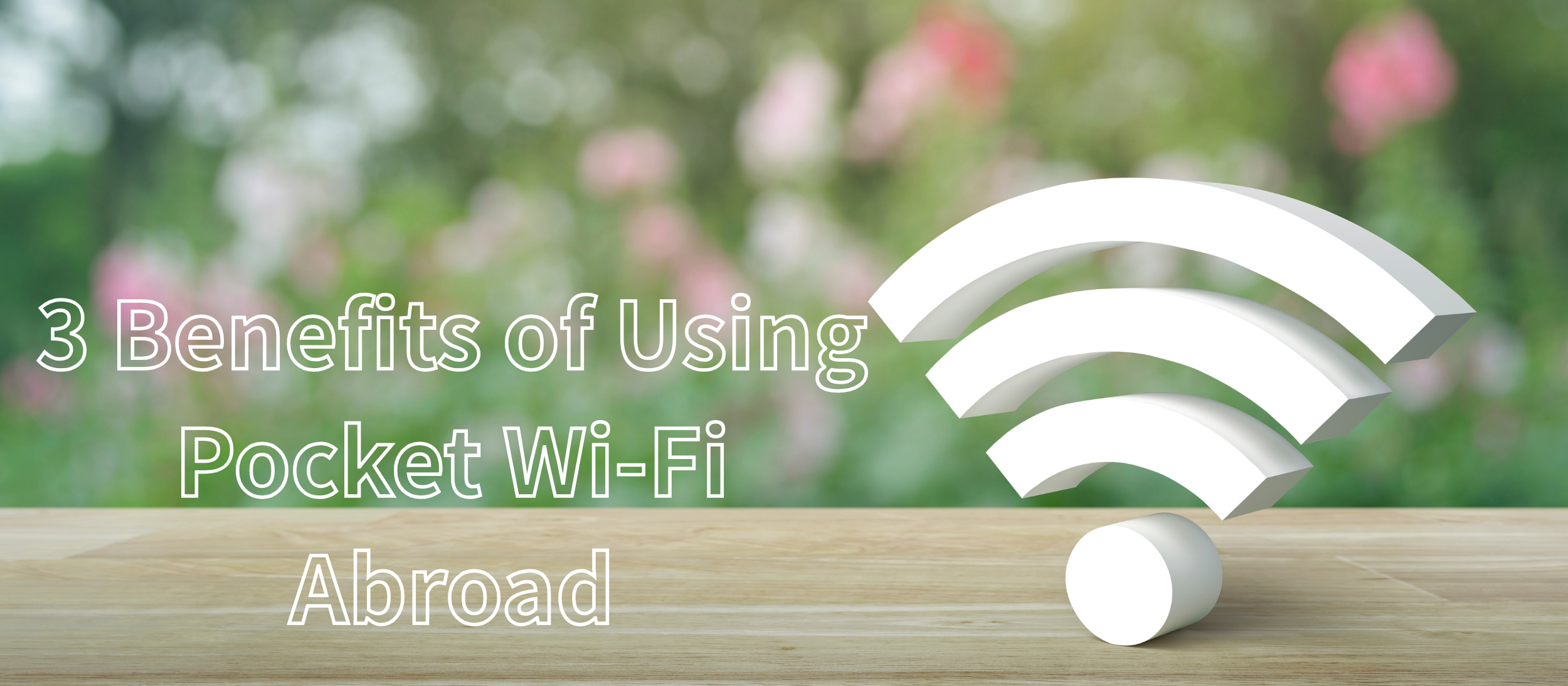
Top 3 Benefits of Pocket Wi-Fi for International Travel
- Connect multiple devices at once
- Stable and reliable internet connection
- Easy setup without smartphone configuration
Let’s take a closer look at each advantage.
Connect Multiple Devices at Once
Pocket Wi-Fi allows multiple devices to connect to the internet simultaneously, including smartphones, tablets, and laptops. This feature is especially convenient for family trips or group travel, where several people need internet access at the same time.
Sharing a single portable Wi-Fi device helps reduce overall communication costs since each traveler does not need to purchase a separate data plan. Streaming videos, browsing, and social media use remain smooth, ensuring a comfortable internet experience abroad.
If you plan to share the connection or use multiple devices, choosing a plan with sufficient data capacity is recommended.
Stable and Reliable Internet Connection
Portable Wi-Fi typically uses local carrier networks, providing high-speed and stable internet connectivity. In cities or tourist areas with well-developed infrastructure, pocket Wi-Fi devices can leverage strong local networks for seamless browsing, video calls, and online navigation.
In some regions, pocket Wi-Fi may offer a more stable connection and faster speed than eSIMs, especially when multiple devices are connected simultaneously. Using a local carrier network reduces connectivity concerns, making pocket Wi-Fi a reliable choice for international travelers.
Easy to Use Without Smartphone Setup
Pocket Wi-Fi requires no SIM card swapping or eSIM configuration. Simply turn on the device, enter the Wi-Fi password, or scan the displayed QR code, and you’re online instantly.
This ease of use benefits first-time international travelers or anyone who finds smartphone settings complicated. Unlike eSIMs, which may require setup in advance, pocket Wi-Fi allows you to connect immediately upon arrival. Travelers can focus on enjoying their trip without worrying about complicated setup processes.
3 Drawbacks of Using Pocket Wi-Fi Abroad
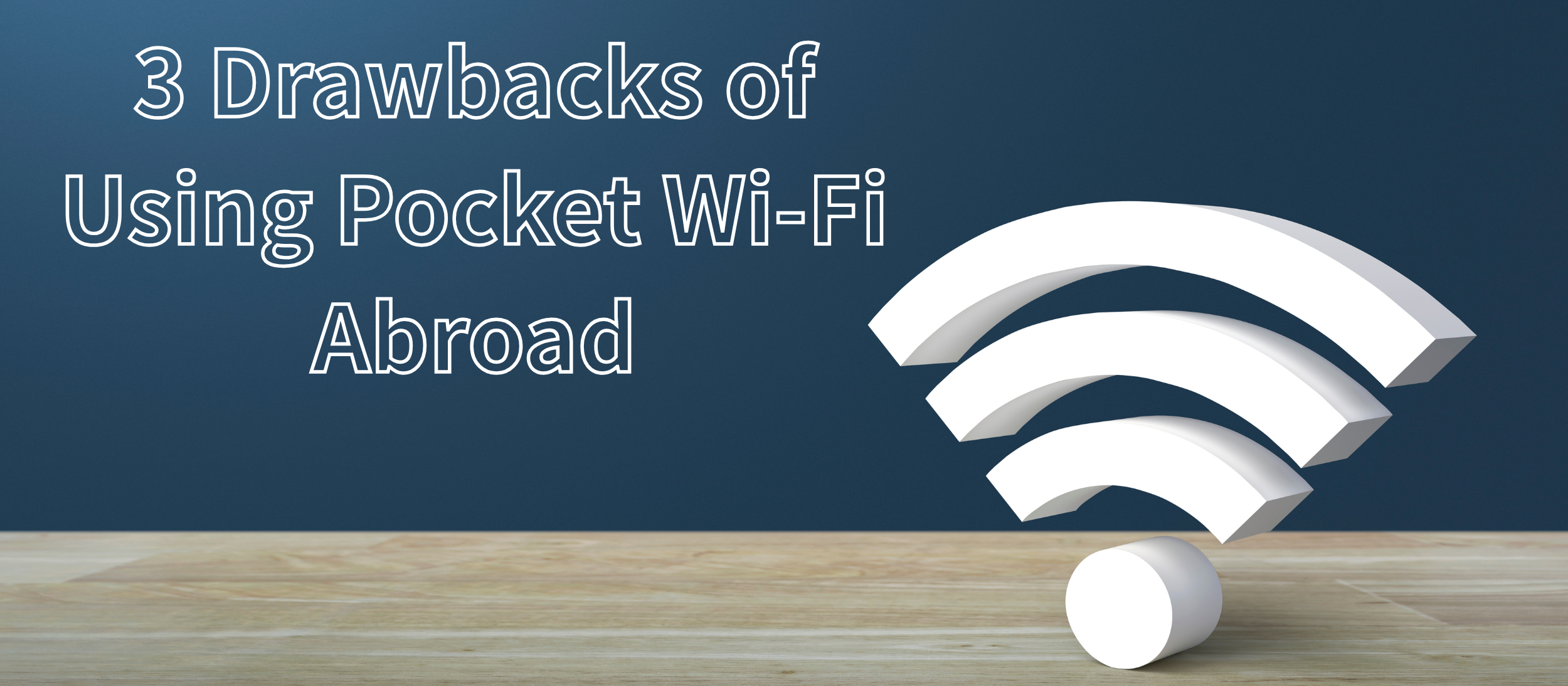
While pocket Wi-Fi is convenient, it does have some drawbacks for international travelers. Here are the top three disadvantages:
Top 3 Disadvantages of Pocket Wi-Fi for International Travel
- Requires charging and carrying extra equipment
- Risk of loss or theft
- Hassle of pickup and return
Requires Charging and Carrying Extra Equipment
Pocket Wi-Fi devices run on batteries and need to be charged, just like smartphones. If you plan to use it frequently during a long day out, running out of battery can leave you without access to maps, online research, or communication.
Additionally, carrying the device itself along with chargers or power banks adds extra weight to your luggage. Travelers who prefer to travel light may find this inconvenient. To avoid unexpected issues, it’s recommended to bring a portable charger or extra battery when traveling.
Risk of Loss or Theft
Since pocket Wi-Fi is a physical device, there is always a risk of loss or theft. In some countries, theft is more common than in Japan, so travelers need to be vigilant.
Losing your device can leave you without internet access for a period of time, which may be inconvenient during trips. To minimize risks, keep the device within sight, and consider having a backup option like an eSIM for critical communication needs.
Hassle of Pickup and Return
If you rent a pocket Wi-Fi device, you usually have the option of picking it up at the airport or having it delivered to your home. While home delivery allows you to start using it immediately upon arrival, returning the device can be inconvenient.
Returning at the airport may involve long queues or busy counters, while mailing it back requires careful packaging and arranging shipment yourself. Furthermore, any loss or damage to the device can result in additional fees, so extra care is needed.
Choosing the Right eSIM as an Alternative
With many eSIM options available for travel, it can be confusing to know which one is best for you. Choosing solely based on “low cost” or “unlimited data” may lead to issues like insufficient speed or capacity abroad.
To use eSIMs effectively, pay attention to key factors such as network quality, plan details, and setup process. The following three points can help you select the right eSIM for your travel needs.
Top 2 Points to Consider When Choosing an eSIM
For first-time eSIM users, it can be confusing to know what to look for. Here are the three most important points to keep in mind when selecting an eSIM for overseas travel:
Top 2 Points to Consider When Choosing an eSIM
- Can it provide stable connectivity at your destination?
- Does it offer the right data plan for your stay and usage?
- Is Japanese-language support available?
Stable Connectivity at Your Destination
The most important factor is whether the eSIM provides a reliable internet connection where you are traveling.
Different eSIM providers connect to different local carriers, and the quality of service can vary even within the same country. When choosing an eSIM, check the following:
Checklist
- Is it partnered with a reputable local carrier? (e.g., AT&T or T-Mobile in the U.S.)
- Do user reviews indicate stable speed and connectivity?
- Does it support automatic switching between multiple carriers (“multi-carrier support”)?
For trips outside major cities, make sure the eSIM can connect to a carrier with wide coverage. Comparing eSIMs based on “ease of connection” helps avoid stress when accessing maps, social media, or translation apps abroad.
Data Plan Suitable for Your Stay and Usage
eSIM plans come in various types, and choosing solely based on “low price” can result in insufficient or wasted data.
Select a plan that matches your intended usage and trip duration:
Common eSIM Plan Types
- Daily data limit (e.g., 1GB per day)
- Unlimited data for a fixed number of days
- Total data allowance for the trip (e.g., 5GB for 7 days)
Here’s a rough guide for choosing the right amount of data:
Data Usage Guide
- Mainly social media, maps, and translation apps → 500MB–1GB per day
- Frequent video streaming or tethering → 2GB or more per day
- Short business trips → Total-use plans are convenient
- Long-term travel → Daily plans or unlimited plans are recommended
Choosing a plan that matches your actual needs helps balance cost and data usage effectively.
Important Cautions When Choosing an eSIM
While eSIMs are convenient, choosing the wrong plan or device can lead to issues such as “no connection abroad” or “insufficient data.” Pay special attention to the following points:
Important Cautions When Choosing an eSIM
- Not all devices support eSIM
Not all smartphones are compatible with eSIMs. Generally, iPhones from XS onward support eSIM, while Android compatibility varies depending on the model. - Profile reissue may not be possible
Some eSIMs cannot be reissued if you accidentally delete the QR code. Be careful not to remove it while it’s in use. - Pay attention to activation timing
Some eSIMs start counting their validity period as soon as the QR code is scanned. Make sure to check whether it activates before your departure or only upon arrival.
How to Choose the Right Pocket Wi-Fi for Travel
While it may seem “safe to just rent one,” not all pocket Wi-Fi services are created equal. Differences in speed, coverage area, and pricing can make a big difference. Choosing the wrong service could lead to problems like slow connections or data limits being reached while abroad.
To ensure a smooth internet experience, it’s important to consider data allowance, coverage, and usage needs. Here are three key points to keep in mind when selecting a pocket Wi-Fi device.
Top 3 Points for Choosing Pocket Wi-Fi
Compared to eSIMs, pocket Wi-Fi offers advantages for multiple users and high data usage. However, choosing the wrong service can cause inconvenience. Here are three points to check when making your selection:
Balance Between Data Allowance and Speed
While most pocket Wi-Fi plans advertise “unlimited use,” many have daily or multi-day usage limits. Once these limits are exceeded, speed restrictions may apply, making activities like video streaming or online meetings difficult.
For example, if you plan to watch high-quality videos or connect multiple devices, a plan with at least 3GB per day is recommended to avoid interruptions.
Coverage Area and Connection Stability
The quality of pocket Wi-Fi depends heavily on the local carriers it partners with. Even if the coverage area looks wide, some devices may struggle outside city centers. Checking user reviews and feedback is a good way to gauge reliability.
Devices that automatically switch between multiple networks tend to provide a more stable connection, especially in areas with fluctuating coverage.
Data Allowance Based on Trip Duration and Usage
Short trips and long stays require different data plans. Even “unlimited” plans may have subtle differences depending on the rental duration. Choosing a plan that matches your stay and intended use is crucial.
Individual use for maps and social media: mid-range data plans are usually sufficient.
Family or group sharing: large-capacity plans are recommended.
Important Notes When Renting Pocket Wi-Fi
Even the most convenient pocket Wi-Fi can cause stress if not prepared properly. First-time renters should pay attention to the following points:
Important Points When Renting Pocket Wi-Fi
- Pickup and Return Options
Methods vary by service: airport pickup, home delivery, or in-store. Choose the option that fits your travel schedule. - Battery Life
If you’ll be out all day, bring a portable charger or choose a model with replaceable batteries. - Connection Speed for Multiple Users
The more users connected, the slower the speed can get. Pick a device that matches the number of people sharing it.
Checking these points before your trip can prevent stress and trouble on the ground. Taking a little time before renting ensures a smooth and reliable internet experience while traveling.
Top 3 eSIM Services for International Travel in 2025
Planning an international trip? Staying connected abroad is easy with a reliable eSIM. In this guide, we introduce three trusted eSIM services perfect for travelers. Whether you need unlimited data, 24/7 support, or user-friendly Japanese apps, these options cover all your needs.
| [Oct 2025] Best 3 eSIM Services for International Travelers | |
|
|
|
|
|
|
JapanConnect eSIM | One of the Most Affordable Medium Data Plans!
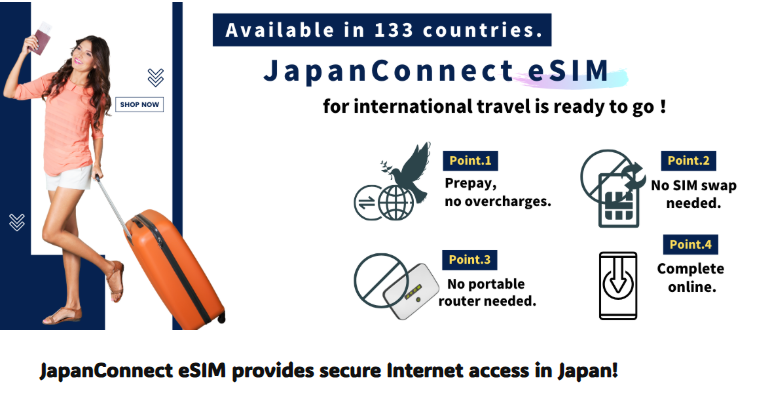
(Image source: JapanConnect eSIM Official) |
|
| Supported Countries | 133+ |
| Recommended Regions | Asia, Europe, Africa |
| Recommended Data Plans | 5GB – 20GB |
| App Support | ✕ |
| Tethering / Hotspot | ✅ |
| Customer Support | LINE (Japanese) |
| Support Hours | 9:00–18:00 JST (365 days) |
| Payment Method | Credit Card |
| Validity | 60 days |
| Company | BeaconLink LLC |
| Benefits | Notes |
|
|
JapanConnect eSIM is an affordable eSIM service for international travelers provided by the Japanese company BeaconLink LLC. It covers 133 destinations worldwide, including popular regions like Japan, Europe, the United States, and Southeast Asia. The service has quickly gained recognition for its industry-leading low prices, making it ideal for budget-conscious travelers who want reliable connectivity without breaking the bank.
Plans are very reasonable with flexible data options ranging from 1GB to Unlimited for trips lasting 1 to 30 days. The company provides instant QR code delivery via email, allowing you to get online within minutes of purchase. Setup is remarkably simple: just scan the QR code and follow the on-screen prompts—even first-time eSIM users can complete installation in under 5 minutes.
One particularly reassuring feature is JapanConnect's 30-day return policy for uninstalled eSIMs, giving you peace of mind if your travel plans change unexpectedly. However, once you've installed and activated the eSIM, it cannot be returned or refunded—so only install it when you're ready to travel.
The service is available both on Amazon and through the official JapanConnect store. While Amazon offers convenience, the official store frequently features exclusive coupon codes and lower base pricing, making it the better deal for savvy shoppers. Customer support is available 365 days per year (9:00-18:00 JST) in multiple languages including English and Japanese.
With growing positive reviews praising its exceptional value and ease of use, JapanConnect has established itself as a smart choice for travelers looking for affordable, hassle-free connectivity—especially those visiting Japan or other Asian destinations.
Visit JapanConnect eSIM Official Site
✓ Use our exclusive 5% OFF coupon code: ESIMPOTAL01
CHECK
-

-
JapanConnect eSIM Review 2025: Best Prepaid eSIM for Japan Travel
JapanConnect eSIM is a popular prepaid eSIM service for short-term use during Japan travel. eSIM can ...
続きを見る
Holafly | Unlimited Data Plans for Global Travelers
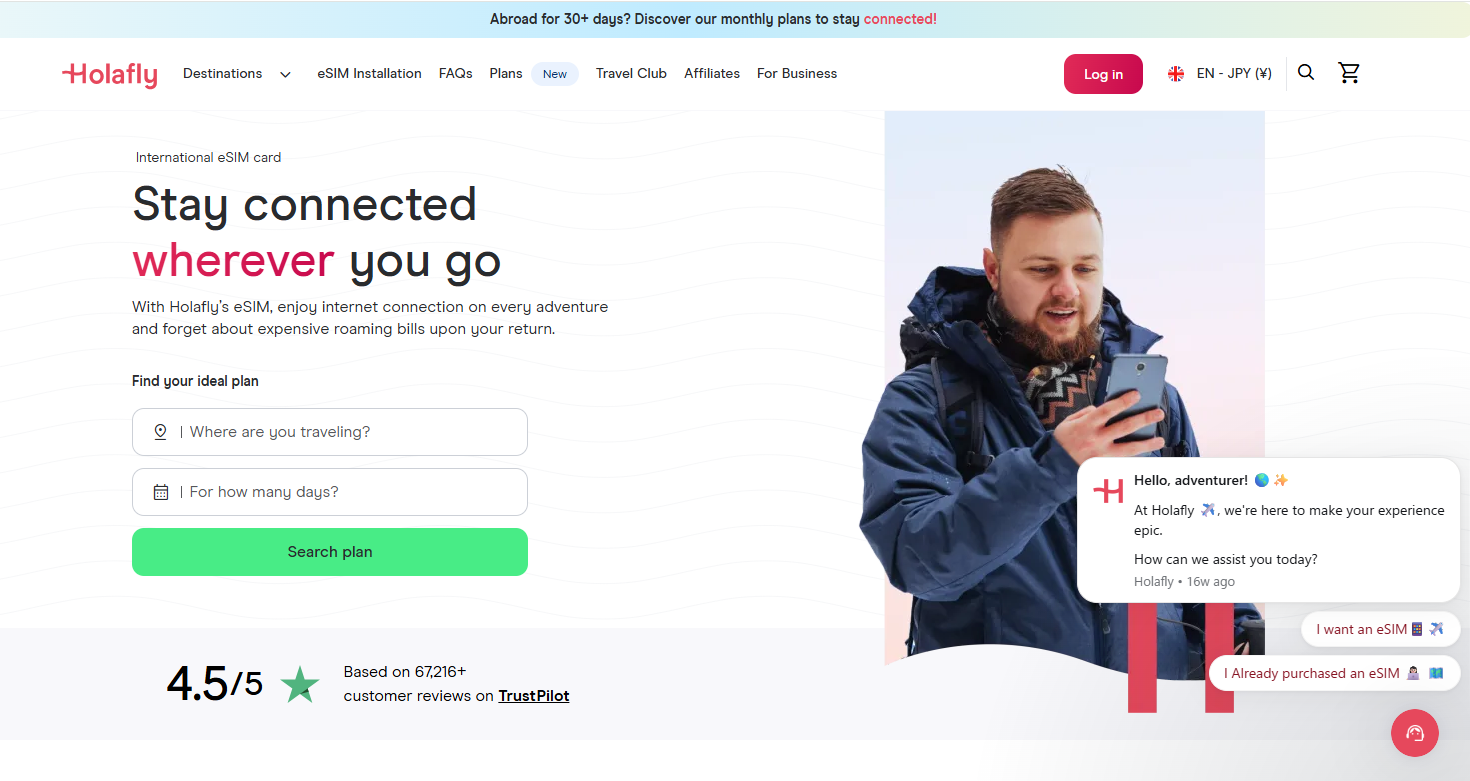
(Image source: Holafly Official) |
|
| Coverage Countries | 200+ countries |
| Recommended Regions | Asia, Europe, North & Central America, Middle East |
| Recommended Data Plans | Unlimited |
| App Support | Yes (Japanese not supported) |
| Tethering | Partial (depends on plan) |
| Customer Support | Chat support |
| Support Hours | 24/7 |
| Payment Methods | Credit Card, Apple Pay, Google Pay, PayPal |
| Validity | No expiration |
| Company | Holafly, Ireland |
| Advantages | Cautions |
|
|
Holafly is an international eSIM service that stands out for its unlimited data plans, now available in over 200 countries. It's becoming increasingly popular among travelers who need reliable internet access abroad without worrying about data caps or roaming charges. Plans start at around $6-7 (USD) per day, making it a solid choice if you're someone who uses a lot of data while traveling—whether for navigation, social media, video calls, or streaming.
The company is based in Ireland, but don't let that worry you—they offer 24/7 chat support with auto-translation in 18 languages, so you can communicate in your preferred language. They also have multilingual staff available including Japanese-speaking support, which is reassuring if you run into any issues during your trip.
That said, Holafly isn't perfect for everyone. They focus mainly on unlimited data plans, so if you're looking for smaller, budget-friendly options for light usage, you might be out of luck.
The connection speed can also be a bit inconsistent depending on where you are and which local network you're connecting to—users typically experience 10-30 Mbps download speeds, which is fine for most activities but may slow down during peak hours or after heavy usage. But honestly, that's a fair trade-off considering you're getting unlimited data at a competitive price point.
✓ Use coupon "APPHAX5" for 5% OFF
CHECK
-
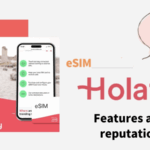
-
Holafly eSIM Japan Review Is Unlimited Data Worth It? Pros, Cons & Speed Test Results
Holafly is a prepaid eSIM for international travel covering 200+ countries worldwide. The key attrac ...
続きを見る
Nomad eSIM | Affordable International Travel Data Starting at $4.50
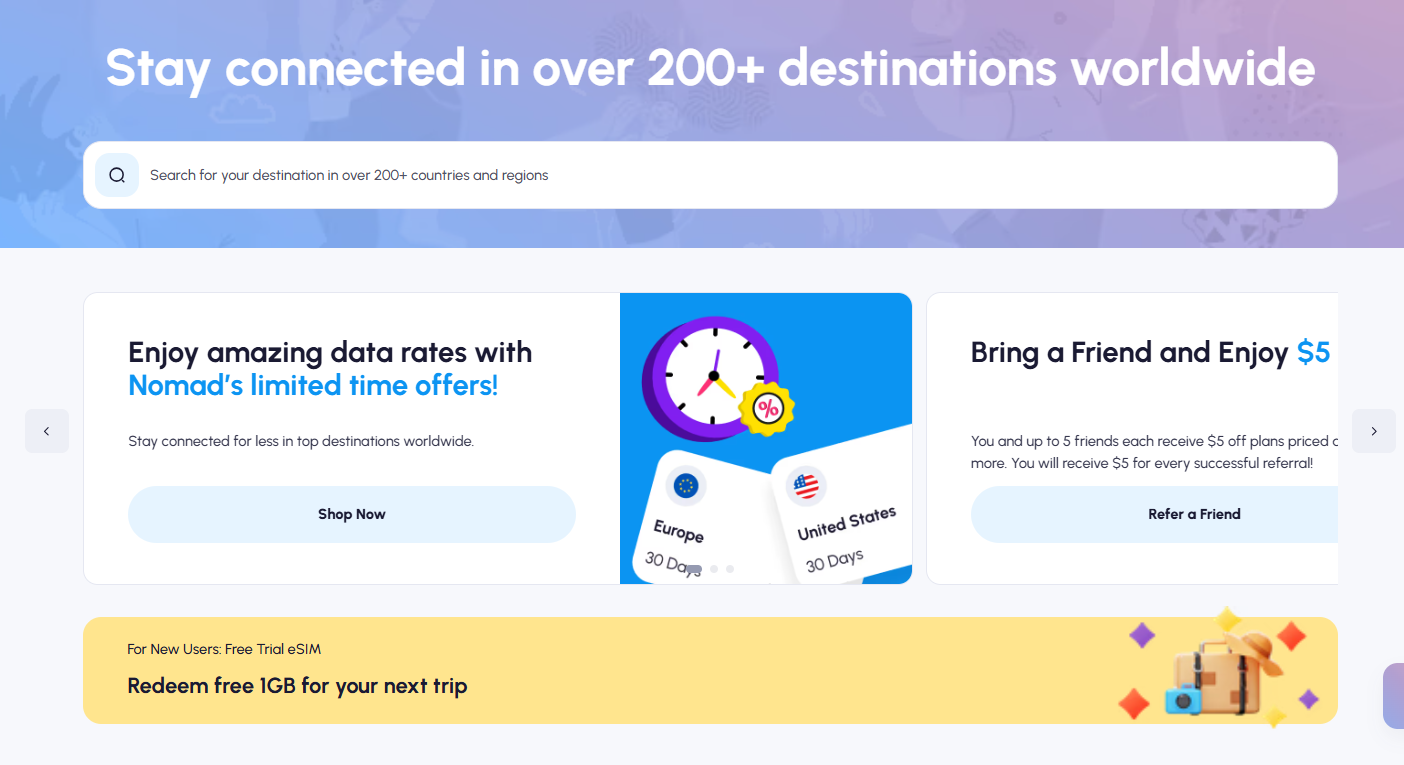
(Image source: Nomad eSIM Official) |
|
| Supported Countries | 200+ |
| Recommended Regions | Asia, Europe, Africa |
| Recommended Data Plans | 1GB – Unlimited |
| App Support | 〇 |
| Tethering / Hotspot | ✅ |
| Customer Support | Chat/ Web form |
| Support Hours | 24/7 |
| Payment Method | Credit Card, PayPal, Apple Pay, Google Pay, Link |
| Validity | 60 days |
| Company | LotusFlare |
| Benefits | Notes |
|
|
Nomad eSIM is an international travel eSIM service provided by the Silicon Valley-based company LotusFlare Inc. Launched in 2020, it has quickly gained popularity among global travelers for its ease of use and extensive coverage across over 200 destinations worldwide, including popular regions like Europe, Asia, North America, and Africa.
The service offers competitive pricing with transparent per-GB rates starting from as low as $4.50, and the company frequently provides promotional discount codes. Users can choose from flexible data plans tailored to their travel needs, with regional plans being particularly convenient for multi-country trips—eliminating the need to switch eSIMs as you cross borders. Most plans include hotspot support, making it easy to share your connection with other devices or traveling companions.
Setup is remarkably simple: install the eSIM through the mobile app with just one tap, or scan the QR code sent via email after purchase. Even first-time eSIM users can get connected within minutes. Most plans activate automatically when you land at your destination, so your data allowance doesn't start counting until you actually need it—a feature that prevents wasted data during travel time.
One standout feature is Nomad's free 1GB trial available in 48 countries for 3 days, allowing you to test the service before committing to a larger plan. This gives you confidence that everything works properly with your device and the local networks.
With a 4.5-star rating on Trustpilot and thousands of positive reviews, Nomad has established itself as a reliable choice for travelers who want hassle-free connectivity without the premium prices charged by traditional roaming services or unlimited-only providers like Holafly.
Visit Nomad eSIM Official Site
✓ Use our exclusive 5% OFF coupon code:
CHECK
-
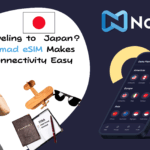
-
Nomad eSIM for Japan Travel: Top 5 Benefits, Pricing, Speed & Competitor Comparison
Traveling to Japan? Forget swapping physical SIMs—eSIMs let you connect instantly without the hassle ...
続きを見る
Top 2 Pocket Wi-Fi Services for International Travel
If you want minimal setup hassle, stable connections, and the ability to share with multiple users, pocket Wi-Fi is a strong option. Here, we have carefully selected the top 2 easy-to-use services. Find the one that fits your travel needs.
| [Oct 2025] Recommended Pocket Wi-Fi for International Travel - Best 2 | |
|
|
|
|
WiFiBOX | Portable Wi-Fi and Power Bank in One

(Image Source: WiFiBOX Official) |
|
| Available Countries | 130+ |
| Recommended Data Plans | Unlimited/day, 1GB/day, 500MB/day |
| Max Connected Devices | Up to 5 devices |
| Booking Available From | 2 days before use |
| Pick-up / Return Locations | Airports / Train Stations / Shopping Malls |
| Business Hours | 9:00–18:00 (Weekdays only) |
| Customer Support | Phone support only |
| Payment Methods | Credit Card / Google Pay / PayPay |
| Provider | Telecom Square, Inc. |
| Pros | Cons |
|
|
WiFiBOX is a self-rental portable Wi-Fi service that allows users to rent and return a router simply by scanning a QR code on a dedicated machine. Installed in over 400 locations across Japan, including major airports, train stations, and shopping centers, it enables quick and contactless pickup before departure or after returning home.
Each WiFiBOX unit comes with three built-in charging cables — Type-C, Lightning, and Micro USB — so it can also be used as a power bank in emergencies. However, since it consumes the main battery faster, using it mainly for short charging is recommended.
Covering around 130 countries worldwide, WiFiBOX offers unlimited data plans that support social media, streaming, and video calls without worrying about data limits. It’s also among the most affordable portable Wi-Fi options on the market.
“It’s so convenient — just scan the QR code with your phone and start using Wi-Fi right away without waiting at a counter!”
The biggest advantage of WiFiBOX is its hassle-free and contactless rental process. It’s ideal for travelers who want to minimize the time and effort required for travel preparation.
\ Stress-free self Wi-Fi rental — perfect for travelers in a hurry /
Global Wi-Fi | Unlimited Pocket WiFi Rental for International Travel
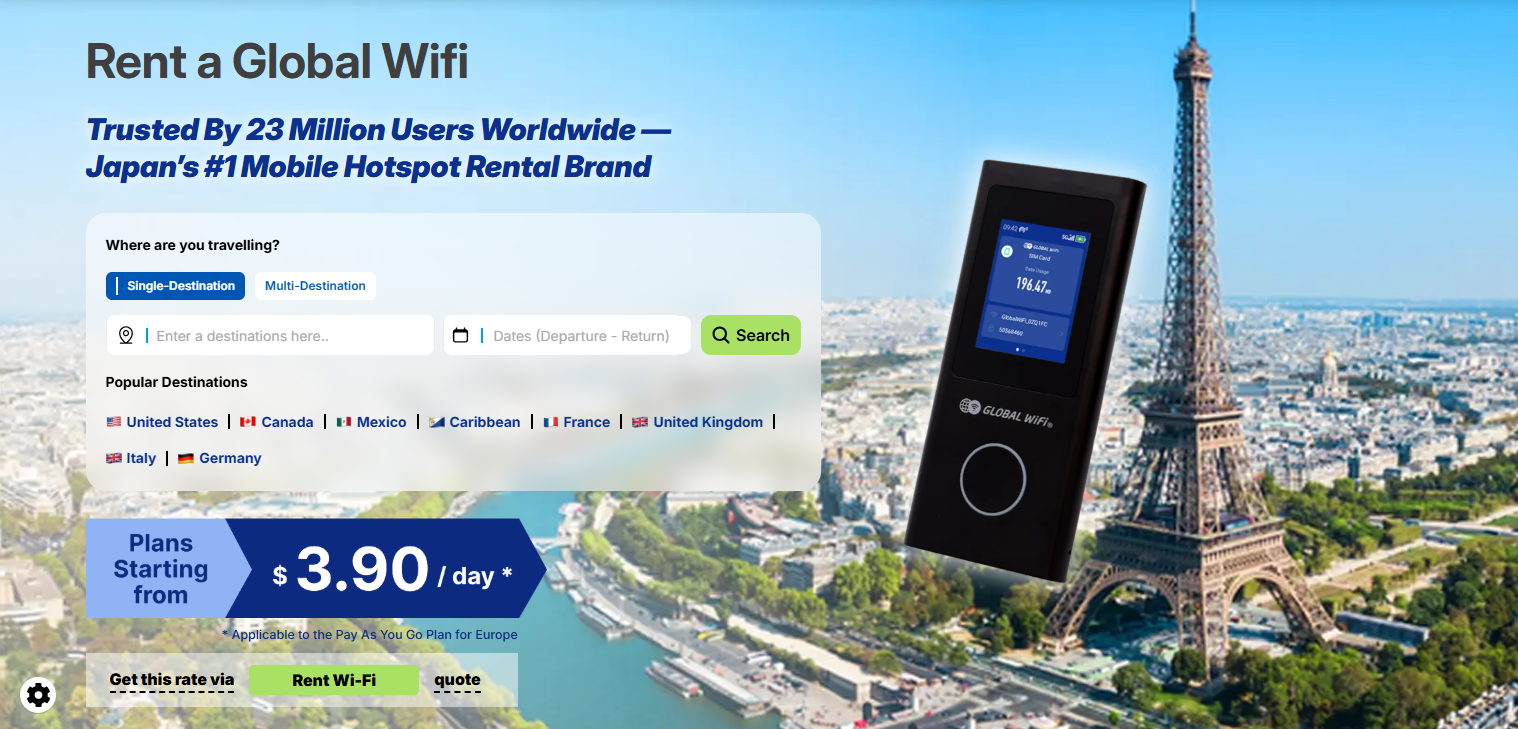
(Image source: Global WiFi Website) |
|
| Supported Countries | 200 countries+ |
| Recommended Data Plans | Unlimited / day, 1.1GB / day |
| Max Connected Devices | Up to 5 devices |
| Pick-up Date | 8 days before departure |
| Pick-up / Return Locations | Courier / Convenience Store / Airport |
| Business Hours | It depends. |
| Customer Support | Phone & Chat (24/7 support) |
| Payment Methods | Credit Card, PayPal |
| Company | Vision |
| Advantages | Notes |
|
|
Global WiFi stands out for its exceptional value with a straightforward daily flat-rate system: daily rate × travel days = total cost. Book early and save significantly with their advance discount.
Competitive rates across Japan and Asia make it budget-friendly, with transparent pricing that lets you calculate expenses upfront—no hidden surprises.
"Unlimited data at these rates? Global WiFi delivers outstanding value for international travelers!"
Connect up to 5 devices simultaneously, perfect for sharing with your group. Split the cost and it becomes far more economical than individual data plans or SIM cards per person.
Round-the-clock multilingual support ensures help whenever needed, regardless of time zones. Phone and messaging app support provide quick, convenient assistance.
Flexible pickup and return options include airport counters, return boxes, courier services, and convenience stores. Return at your own pace after your trip—no rushing back to the airport.
Global WiFi addresses key traveler concerns: transparent pricing, comprehensive support, and convenient logistics. Optional damage protection covers breakage, water damage, loss, or theft, ensuring worry-free connectivity throughout your travels.
✓ 200+countries and 24/7 support
Visit Global WiFi Official Site
Summary | Which Should You Choose: eSIM or Pocket Wi-Fi?
Both eSIMs and pocket Wi-Fi routers have their own pros and cons. The right choice depends on your travel style and how you plan to use the internet during your trip.
Use the comparison below to decide which option best fits your needs.
eSIMs are ideal for tech-savvy travelers who prefer an easy, app-based setup and want to use data individually.
Meanwhile, Pocket Wi-Fi devices are more reliable for groups or heavy data users who plan to connect multiple devices.
When choosing between them, consider the following points:
- Is your smartphone eSIM-compatible?
- Will you use it alone or share it with others?
- How important are data capacity and speed to you?
Use these criteria to find the best option for your trip.
Either choice will let you stay connected comfortably during your travels abroad.
Frequently Asked Questions
We’ve gathered the most common questions about eSIMs and pocket Wi-Fi.
If you’re unsure which to use for your next trip, this section will help you decide.
FAQ
- Do I need Wi-Fi if I have an eSIM?
- Which is better for travel — SIM or Wi-Fi?
- Does eSIM setup require Wi-Fi?
- How much data do I need per day with an eSIM?
- How long does a pocket Wi-Fi battery last?
- Can I use eSIMs in every country?
- Which is better for group travel?
- Which suits long-term stays better?
- Which is safer — eSIM or pocket Wi-Fi?
- Which offers better battery life?
- Which has faster connection speed?
Do I need Wi-Fi if I have an eSIM?
Generally, you don’t.
If your smartphone supports eSIMs, you can connect directly to a local carrier network.
However, if you plan to share the connection with multiple people, pocket Wi-Fi is more convenient.
Which is better for travel — SIM or Wi-Fi?
For solo travelers or those who use only a smartphone, eSIMs are simple and ideal.
For groups or those who use laptops and tablets, pocket Wi-Fi provides more flexibility.
Does eSIM setup require Wi-Fi?
Yes, you’ll need an internet connection once during the initial setup.
We recommend activating your eSIM at home or using airport Wi-Fi before departure.
How much data do I need per day with an eSIM?
For most travelers, 1-2GB per day is enough.
If you mainly use maps, social media, and web searches, 1GB is fine — but choose more if you often stream videos.
How long does a pocket Wi-Fi battery last?
Most devices last about 8-12 hours on a full charge.
If you’ll be outdoors all day, bring a power bank just in case.
Can I use eSIMs in every country?
eSIMs work in many destinations, but coverage varies by provider.
Always check whether your eSIM plan supports your travel destination before purchasing.
Which is better for group travel?
Pocket Wi-Fi is great for sharing a single connection among multiple people.
If everyone prefers independence or plans separate activities, eSIMs are the better choice.
Which suits long-term stays better?
If you want flexibility, eSIMs are ideal since plans can be easily changed or extended.
However, heavy data users or those with multiple devices may prefer a pocket Wi-Fi with a large data plan.
Which is safer — eSIM or pocket Wi-Fi?
Both are secure options since they provide private connections.
Unlike public Wi-Fi, they protect your data from third-party access or interception.
Which offers better battery life?
eSIMs use your phone’s built-in network function, so there’s no need to charge a separate device.
Pocket Wi-Fi requires charging, so carrying a small power bank is recommended.
Which has faster connection speed?
Both depend on local network coverage.
If they use the same carrier, the speed difference is typically negligible in real-world use.
